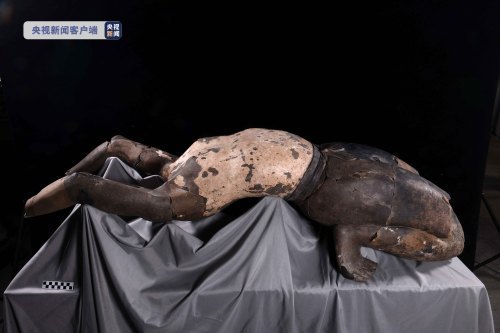Hubei Shiyan Archeology was recently discovered "Langxian People" No. 3 skull, which evidenced by the history of human beings in my country's millions of years
Author:Wuhan Evening News Time:2022.09.28

On September 28th, the State Administration of Cultural Relics.
Wuhan Evening News, September 28 (Reporter Wan Jianhui) This morning, the State Administration of Cultural Relics held a major "archeological China" project launch conference to report new archeological discoveries from Hubei, Yunnan, Wenzhou, and Kaifeng. Among them, the new discovery of major archeological China projects reported, the Liangzi site of Shiyan Xuexuexuexue, Hubei, newly discovered a new ancient human skull fossil- "Xianxian people" No. 3 head bone.
The most complete upright skull fossils found in Eurasia's inland

Shiyan Xuexueliangzi site position.
On the morning of the 28th, Fang Qin, the dean of the Hubei Provincial Institute of Cultural Relics and Archeology, introduced in an interview with reporters that the Liangzi site of the school is located in Liyang District, Shiyan City, Hubei Province. In 1989 and 1990, the Liangzi site of the academy discovered two ancient human skull fossils. It was about 1 million years old. It belonged to the upright person and was named "Xianxian people" by the academic community. With the approval of the State Administration of Cultural Relics, since 2021, the Hubei Provincial Institute of Cultural Relics and Archeology and the Chinese Academy of Sciences and the ancient Human Research Institute, Wuhan University and other units have systematically archeological excavations on the Liangzi site of the school.

Discovery the excavation site of the "Xianxian" No. 3 cord fossil.
Recently, the archeological work of the Liangzi site of the school has made important progress. It was found that a more well -preserved ancient human skull fossil was named, named "Yixian people" No. 3.
The No. 3 skull stone, more than 30 meters from the previous two skull fossils out of the land, found in the cultural layer of about 0.62 meters depth of the ground, and currently exposed the frontal bone (including eyebrow ridges), orbital, top bone, left cheekbones on the left cheekbones on the left side of the surface The left side of the temporal bone and the pillow bone is well -preserved, the shape is clear, and there is no obvious deformation. At the same time, it is also accompanied by a large number of animal fossils and stone products unearthed.

The excavation site of "Yixian people" No. 3 osteotrophic stone.
The No. 3 skull fossil of "Langxian" is similar to the previous two bone -based stone buried environment, the accompanying animal group and the technical characteristics of stone products are similar. Initial judgment should be the same era, and further scientific and technological annual confirmation is required.
The State Administration of Cultural Relics was released this time that on May 18, 2022, the fossils were first exposed, the skull was stored complete, and there were a small amount of glue on the surface. Establishing human skull fossils have evidenced the human history of millions of years in my country.
At present, the lower part of the skull fossil is still in the native soil layer, and the right side is embedded in the south wall. Subsequent extraction and repair plans will be formulated, and comprehensive cross -disciplinary research on the site will be carried out simultaneously.
"Yixian people" No. 3 skull fossil first exposed
According to Fang Qin, the Liangzi site of the school is located in Miduo Temple Village, Qingqu Town, Liyang District, Shiyan City, Hubei Province. On May 18, 1989, in the second national cultural relics census, the Liangzi survey of the school discovered "Yixian people" No. 1 skull stone; the following year, the first formal excavation of the Liangzi site of the school was unearthed. Human "No. 2 skull stone, and found a large number of animal fossils and stone relics.

"Yixian people" No. 1 and 2 skull stone.
The distribution range of this site is 1.9 million square meters, and it has preserved the accumulation of strata stacks, grade sequences, and systematic ancient environment information of different periods for more than 1 million years. Academic value. In June 2001, the State Council announced the Liangzi site of the school as the fifth batch of national key cultural relics protection units.
In 2021, the Hubei Provincial Institute of Cultural Relics and Archeology excavated a 105 -square -meter area at the Liangzi site of the school, about 4 meters deep, 83 stone products unearthed, and excavated a 126 square meter area, about 1.6 meters deep, unearthed stone, unearthed stone 148 products, discovered the late relics of the old stone era, extended the history of ancient human activities in the Liangzi site of the school.

The "Yixian County" stored in Hubei Provincial Museum 2.
A total of 203 square meters of excavations were revealed this year, and an important gain was obtained: one piece of ancient human skull fossils were unearthed, and 45 pieces of stone products, which can be distinguished by 205 pieces of animal fossils. The types of recognized animal fossils include sword teeth, rhinos, rhinos, cows, deer, monkeys, wild boars, piglets, dogs, large cats, etc.
On the morning of May 18 this year, fossils were first exposed, and preliminary cleaning according to the prescribed fossil excavation procedures. At 4:30 pm, Lu Chengqiu, the person in charge of the project, initially confirmed that it was an ancient human skull fossil, and then stopped excavation, maintained its original state, strengthened security, and reported to relevant leaders and experts in accordance with procedures. Experts such as Researcher Xing Song and other experts Xing Song and other experts from the Institute of Ancient Human Research Institute of the Chinese Academy of Sciences conducted video connection to further determine it as ancient human skull fossils.

In response to this important discovery, the archeological team promptly formulated the excavation and research plan of the "Xixian people" 3 skull and cultural relics with rigorous and multi -disciplinary cross -disciplinary, and was approved by the State Administration of Cultural Relics. The Hubei Provincial Government and the relevant departments of the Chinese Academy of Sciences organized an expert group composed of a number of academicians, members of the department, and other professionals to conduct a systematic inspection and demonstration. Essence
New discovery further empirical evidence of the history of the hometown of Eastern human hometown is long.

Archaeologists are initially cleaned up to observable state in accordance with the prescribed procedures for the "Xianxian people".
Fang Qin said that the No. 3 skulls discovered this time provided precious materials for studying ancient humans and their survival methods at that time. The "people of the county" are on the key node of the 2 million years of evolution of ancient human beings. The No. 3 skull is the most intact ancient human skull fossil found in Eurasia in the inland inland in Eurasia. Major topics, East Asian upright people and the evolution of the Homo sapiens provided informative and key fossils and cultural evidence. Archaeologists are discovering the excavation site of the "Langxian People" No. 3 cord fossil.

The "Langxian People" No. 3 cord fossil is a major archeological discovery in my country and even the international academic community in 2022. It further empirically empirically evolves has a long history of Oriental Human hometown, and the ancient Chinese ancient culture is profound. Compared with the unearthed and squeezed and deformed, more than 30 years ago, the No. 1 and 2 skulls of Luxian 1 and 2 were preserved more intact, and the characteristics of the uprights were more clear, retaining the important anatomical characteristics of human beings at this stage.
The "Langxian People" No. 3 skull stone maintained the original state (front).

The skull is located in the same set of stratums as the previously unearthed. The symbiotic relationship between the same layer of stone products and mammalian fossils of the same layer is clear. The lively pictures of the ancient crowd's survival and evolution. The "people of the county" are at the key nodes of the evolutionary process of about 2 million years of ancient human beings in Eurasia. Key fossils and cultural evidence.
At present, in response to the excavation and extraction of No. 3 skulls, the expansion and other plans have been formulated and organized by expert groups composed of multiple academicians and members of the Ministry of Studies. In the next step, the excavation team will adopt a multi -disciplinary joint research to do a good job of excavation excavation Extract work.
[Edit: Yu Lina]
- END -
Qinling Yang lying figurines found that fingerprint marksm craftsmen should be teenagers

Emperor Qin Shi Mausoleum K9901 The latest research results unearthed by the funer...
Come to see the \"Paraz\" traditional handicraft exhibition

Winding, weaving ... The colorful wool line passes through a process, and the col...